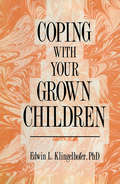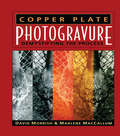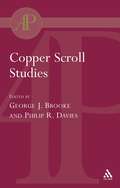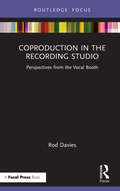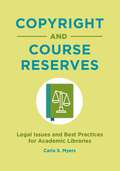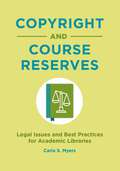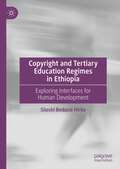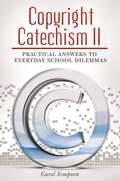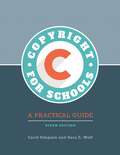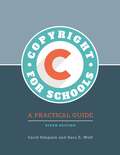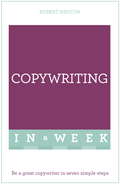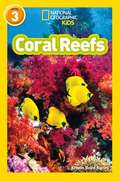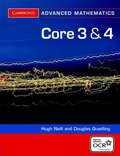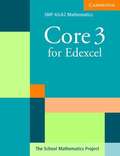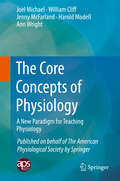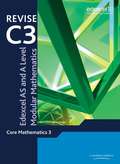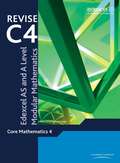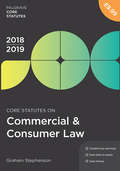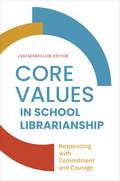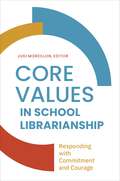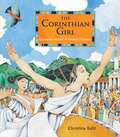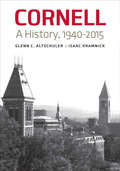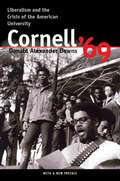- Table View
- List View
Coping with your Grown Children
by Edwin L. KlingelhoferCoping With Your Grown Children is the only book to analyze-and lay out specific coping strategies for dealing with-the problems today's parents face with their adult offspring such as: • failure of the child to really "grow up" or achieve full potential • unemptied nests • moving back home after broken marriages • turning your home into a "daycare center" for your grandchildren • substance abuse, cult involvement, trouble with the law • alternative lifestyles or homosexuality • physical or psychiatric problems • or maybe you just think there's a problem!
Copper Plate Photogravure: Demystifying the Process (Alternative Process Photography Ser.)
by David Morrish Marlene MacCallumCopper Plate Photogravure describes in comprehensive detail the technique of traditional copper plate photogravure as would be practiced by visual artists using normally available facilities and materials. Attention is paid to step-by-step guidance through the many stages of the process. A detailed manual of technique, Copper Plate Photogravure also offers the history of the medium and reference to past alternative methods of practice.Copper Plate Photogravure: Demystifying the Process is part of the current revitalization of one of the most satisfyingly beautiful image-making processes. The range of ink color and paper quality possibilities is endless. The potential for handwork and alteration of the copper plate provides yet another realm of expressive variation. The subject matter and the treatment are as variable and broad as photography itself. This book's purpose is to demystify and clarify what is a complex but altogether "do-able" photomechanical process using currently available materials. With Copper Plate Photogravure, you will learn how to:· produce a full-scale film positive from a photographic negative· sensitize the gravure tissue to prepare it for exposure to the positive · prepare the plate and develop the gelatin resist prior to etching· prepare the various strengths of etching solutions and etch the plate to achieve a full tonal scale· rework the plate using printmaking tools to correct flaws or to adjust the image for aesthetic reasons· use the appropriate printing inks, ink additives, quality papers, and printshop equipment to produce a high quality printA historical survey and appendices of detailed technical information, charts, and tables are included, as well as a list of suppliers and sources for the materials required, some of which are highly specialized. A comprehensive glossary introduces the non-photographer or non-printmaker to many of the terms particular to those fields and associated with this process.
Copper Plate Photogravure: Demystifying the Process
by David Morrish Marlene MacCallumCopper Plate Photogravure describes in comprehensive detail the technique of traditional copper plate photogravure as would be practiced by visual artists using normally available facilities and materials. Attention is paid to step-by-step guidance through the many stages of the process. A detailed manual of technique, Copper Plate Photogravure also offers the history of the medium and reference to past alternative methods of practice.Copper Plate Photogravure: Demystifying the Process is part of the current revitalization of one of the most satisfyingly beautiful image-making processes. The range of ink color and paper quality possibilities is endless. The potential for handwork and alteration of the copper plate provides yet another realm of expressive variation. The subject matter and the treatment are as variable and broad as photography itself. This book's purpose is to demystify and clarify what is a complex but altogether "do-able" photomechanical process using currently available materials. With Copper Plate Photogravure, you will learn how to:· produce a full-scale film positive from a photographic negative· sensitize the gravure tissue to prepare it for exposure to the positive · prepare the plate and develop the gelatin resist prior to etching· prepare the various strengths of etching solutions and etch the plate to achieve a full tonal scale· rework the plate using printmaking tools to correct flaws or to adjust the image for aesthetic reasons· use the appropriate printing inks, ink additives, quality papers, and printshop equipment to produce a high quality printA historical survey and appendices of detailed technical information, charts, and tables are included, as well as a list of suppliers and sources for the materials required, some of which are highly specialized. A comprehensive glossary introduces the non-photographer or non-printmaker to many of the terms particular to those fields and associated with this process.
Copper Scroll Studies: Copper Scroll Studies
by George J. Brooke Philip R. DaviesThis book contains the papers delivered at the 1996 Copper Scroll Symposium which was organized by the Manchester-Sheffield Centre for Dead Sea Scrolls Research to mark the 40th Anniversary of the opening of this enigmatic scroll in Manchester. The papers cover the history of the Scroll's interpretation (P. Muchowski, P. Davies, B. Segal, M. Wise); how it should be conserved, restored and read (N. Cacoudre, M. Lundberg, E. Puech); how it was produced (P. Kyle McCarter); the meaning of its technical terms (J.F. Elwolde, A. Lange, J. Lefkovits, J. Lubbe, L. Schiffman); its genre (M. Bar-Ilan, R. Fidler, T. Lim); its geography (P.S. Alexander); its correlation with archaeological remains (H. Eshel); and not least who wrote it, when and why (S. Goranson, I Knohl, H. Stegemann, B. Thierine, A. Wolters) with an Introduction by G. Brooke. This is volume 40 in the Journal for the Study of Pseudepigrapha Supplement series.
Coproduction in the Recording Studio: Perspectives from the Vocal Booth
by Rod DaviesCoproduction in the Recording Studio: Perspectives from the Vocal Booth details how recording studio environments affect performance in the vocal booth. Drawing on interviews with professional session singers, this book considers sociocultural and sociotechnical theory, the modern home studio space, as well as isolation and self-recording in light of the COVID-19 pandemic. This is cutting-edge reading for advanced undergraduates, scholars and professionals working in the disciplines of recording studio production, vocal performance, audio engineering and music technology.
Coproduction in the Recording Studio: Perspectives from the Vocal Booth
by Rod DaviesCoproduction in the Recording Studio: Perspectives from the Vocal Booth details how recording studio environments affect performance in the vocal booth. Drawing on interviews with professional session singers, this book considers sociocultural and sociotechnical theory, the modern home studio space, as well as isolation and self-recording in light of the COVID-19 pandemic. This is cutting-edge reading for advanced undergraduates, scholars and professionals working in the disciplines of recording studio production, vocal performance, audio engineering and music technology.
Copyright and Course Reserves: Legal Issues and Best Practices for Academic Libraries
by Carla S. MyersWith the guidance of this book, academic librarians wishing to provide print, electronic, and streaming media (music and film) course reserve services for their campus communities can do so in compliance with U.S. copyright law.Many academic libraries offer print and electronic course reserve services that encourage learning by connecting students and faculty with less expensive and supplementary educational materials. Unfortunately, there are many misconceptions regarding how U.S. copyright law affects course reserve services; as a result, many academic libraries restrict the scope of the services they provide or refrain from pursuing new options, such as media reserves, out of fear of violating the law or being sued for copyright infringement. Copyright and Course Reserves addresses this problem, providing authoritative advice for making print, electronic, and media course reserves available in compliance with U.S. copyright law. It explains options for implementing and sustaining media reserve services through which students and faculty can access online music, sound recordings, and film. Additionally, short examples from a wide range of libraries explore real-world scenarios and current issues related to course reserve services to help readers better understand and apply the information found in the book.
Copyright and Course Reserves: Legal Issues and Best Practices for Academic Libraries
by Carla S. MyersWith the guidance of this book, academic librarians wishing to provide print, electronic, and streaming media (music and film) course reserve services for their campus communities can do so in compliance with U.S. copyright law.Many academic libraries offer print and electronic course reserve services that encourage learning by connecting students and faculty with less expensive and supplementary educational materials. Unfortunately, there are many misconceptions regarding how U.S. copyright law affects course reserve services; as a result, many academic libraries restrict the scope of the services they provide or refrain from pursuing new options, such as media reserves, out of fear of violating the law or being sued for copyright infringement. Copyright and Course Reserves addresses this problem, providing authoritative advice for making print, electronic, and media course reserves available in compliance with U.S. copyright law. It explains options for implementing and sustaining media reserve services through which students and faculty can access online music, sound recordings, and film. Additionally, short examples from a wide range of libraries explore real-world scenarios and current issues related to course reserve services to help readers better understand and apply the information found in the book.
Copyright and Tertiary Education Regimes in Ethiopia: Exploring Interfaces for Human Development
by Sileshi Bedasie HirkoThis book explores the interlinkages between copyright and tertiary education regimes, and their complementary roles for sustainable human development. Emphasizing issues that are not addressed in-depth in the existing works, this book employs a new theoretical perspective in order to inform the exploration of the interlinkages through the lens of human development. To this effect, the book adopts the capabilities approach (CA) as an inclusive development framework that is suitable for examining the interfaces among copyright, tertiary education, and human development in Ethiopia.
Copyright Catechism II: Practical Answers to Everyday School Dilemmas (Copyright Series)
by Carol SimpsonThis book contains valid, real-world copyright questions posed by real-life educators—all answered by a knowledgeable and experienced school attorney.For close to a decade, author Carol Simpson fielded and answered inquiries for the "Copyright Questions of the Month" column for Library Media Connection. The questions and answers of this book are gleaned from the myriad copyright questions submitted to her by actual educators in the field, addressing the unique copyright issues in schools.The information in Copyright Catechism II: Practical Answers to Everyday School Dilemmas will be invaluable to K–12 educators of all types, but especially librarians, technology specialists, and school administrators without time to study copyright law in-depth. The topics covered represent the complex and potentially confusing issues that active K–12 educators encounter in their daily work.
Copyright for Schools: A Practical Guide
by Carol Simpson Sara E. WolfCopyright for Schools makes legal concepts related to U.S. copyright law understandable to educators. A staple on reference shelves, it has now been updated with new court rulings and technology applications.This updated edition of Copyright for Schools explains U.S. copyright law as it applies to education settings clearly and concisely for teachers and school librarians. Topics new to this edition include copyright implications related to the use of such streaming services as Netflix™ and Pandora™, links to online tools that teachers can use to assist them in making their own daily decisions regarding the use of copyrighted materials, and implications relating to the use of anonymous internet publishing tools such as Snapchat™ and use of Cloud-based sharing. Other new topics include issues related to disability, how to appropriately respond to cease and desist letters and other legal inquiries, implications of the Music Modernization Act, and expanded discussion of open resources such as Creative Commons licenses. This edition also adds a concordance in a "Scope and Sequence" table format, so all information related to U.S. copyright knowledge is accessible no matter where it resides within the text, and provides links to online tools and resources that can be used to guide users of copyrighted materials in making decisions about how to use them. Still included are the real-world applications and the Q&A sidebars from prior editions.
Copyright for Schools: A Practical Guide
by Carol Simpson Sara E. WolfCopyright for Schools makes legal concepts related to U.S. copyright law understandable to educators. A staple on reference shelves, it has now been updated with new court rulings and technology applications.This updated edition of Copyright for Schools explains U.S. copyright law as it applies to education settings clearly and concisely for teachers and school librarians. Topics new to this edition include copyright implications related to the use of such streaming services as Netflix™ and Pandora™, links to online tools that teachers can use to assist them in making their own daily decisions regarding the use of copyrighted materials, and implications relating to the use of anonymous internet publishing tools such as Snapchat™ and use of Cloud-based sharing. Other new topics include issues related to disability, how to appropriately respond to cease and desist letters and other legal inquiries, implications of the Music Modernization Act, and expanded discussion of open resources such as Creative Commons licenses. This edition also adds a concordance in a "Scope and Sequence" table format, so all information related to U.S. copyright knowledge is accessible no matter where it resides within the text, and provides links to online tools and resources that can be used to guide users of copyrighted materials in making decisions about how to use them. Still included are the real-world applications and the Q&A sidebars from prior editions.
Copywriting In A Week: Be A Great Copywriter In Seven Simple Steps (TYW)
by Robert AshtonGreat copywriting just got easierIt's strange to think that there was a time when only the privileged few could read or write. The rest of us relied on the spoken word. Storytelling was used to pass knowledge on from one generation to the next. Now, most of us are literate and use the written word to gather information and inform our decision making. Increasingly we do this online, with social media and messaging enabling rapid, spontaneous global communication. But rather than freeing us from the need for clear, effective written communication, it actually makes good communication even more important. The less we communicate face to face, the greater the opportunity for misunderstandings. Of course, all writing communicates your message to people you cannot see and may never meet. It means you can influence more widely; it also means you must take care not to make assumptions aboutyour reader, especially those who see your public postings. Successful copywriting is constructed from carefully selected words, each with a clear purpose. It is written to prompt feelings, thoughts or actions. It is clear, concise and at times comforting. It is also comprehensible, even to those not yet confident users of your language. Reading this book, and following the techniques it introduces, will make you a more effective writer. Expertise in grammar is not needed as all the necessary jargon is simply defined and, anyway, some forms of business writing deliberately ignorerules. This book is for people who want to write for results. Each of the seven chapters in Copywriting In A Week covers a different aspect:- Sunday: Focusing your message- Monday: Using layout, pictures and colour to make words memorable- Tuesday: Writing effective letters- Wednesday: Making advertising work for you- Thursday: Communicating clearly with the media- Friday: Preparing promotional print- Saturday: Composing proposals and presentation visuals
Coral Reefs: Level 3 (PDF)
by Kristin Baird Rattini National Geographic KidsNational Geographic Primary Readers is a high-interest series of beginning reading books that have been developed in consultation with education experts. The books pair magnificent National Geographic photographs with lively text by skilled children’s book authors across four reading levels. In this level 3 book, young readers explore the amazing underwater world of coral reefs. Level 3: Becoming independent: Best suited to kids who are ready for complex sentences and more challenging vocabulary, but still draw on occasional support from adults. They are ideal for readers of Purple and Gold books.
Core 3 And 4 For OCR (PDF)
by Douglas Quadling Hugh NeillFully endorsed by OCR and revised to match the 2005 specification, this series has been carefully revised by experienced teachers and provides easy to use texts. Cambridge Advanced Mathematics for OCR encourages achievement by supporting revision and consolidation through review exercises and mock exam papers written by experienced examiners. The books also explore ideas through practical and computer activities.
Core 3 For Edexcel (PDF)
by The School Mathematics ProjectBased on extensive feedback from teachers, these popular A Level titles have been written by the experienced team that produced SMP Interact for GCSE. These are clear, user-friendly texts that both teacher and student will enjoy using. Each chapter's objectives are clearly set out and new concepts are carefully developed in a way that involves the student. Worked examples are designed to clarify ideas and techniques, and there is plenty of well-graded practice and revision, including past exam questions that show the standard required. Key points are highlighted as they arise and are gathered in a summary at the end of the chapter, where there is also a self-assessment section. Each book contains a detailed contents analysis and the chapters are structured so that you can easily tell what part of the specification you are covering. Opportunities for classroom discussion are marked, and starred questions provide extra challenge where needed. 0521605377
The Core Concepts of Physiology: A New Paradigm for Teaching Physiology
by Joel Michael William Cliff Jenny McFarland Harold Modell Ann WrightThis book offers physiology teachers a new approach to teaching their subject that will lead to increased student understanding and retention of the most important ideas. By integrating the core concepts of physiology into individual courses and across the entire curriculum, it provides students with tools that will help them learn more easily and fully understand the physiology content they are asked to learn. The authors present examples of how the core concepts can be used to teach individual topics, design learning resources, assess student understanding, and structure a physiology curriculum.
Core Mathematics 3 (PDF)
by Keith PledgerHelp students push for the top grades with this focused revision guide. Ideal for use alongside the student book, it provides worked exam questions, examples and an array of examiners hints and tips.
Core Mathematics 4 (PDF)
by Keith PledgerIncluding worked examination questions and examples with hints on answering questions successfully, this text demonstrates the key points which reinforce learning and help students to realise their best potential.
core statutes on commercial & consumer law 2018–19 (Palgrave Core Statutes Ser.)
by Graham StephensonWell-selected and authoritative, Palgrave Core Statutes provide the key materials needed by students in a format that is clear, compact and very easy to use. They are ideal for use in exams.
Core Values in School Librarianship: Responding with Commitment and Courage
by Editor Judi MoreillonThis title offers pre-service, newly practicing, and seasoned school librarians opportunities for reflection as well as inspiring strategies for enacting four core values of the profession.The school library profession has been in "crisis" for more than a decade. Educational decision-makers have not been made aware of or sold on the core values of school librarianship and its value to students, classroom teachers, administrators, and the entire school community. Budgetary priorities often do not include school librarians, resulting in a lack of funding and the elimination of many positions, which can cause many school librarians to feel vulnerable and afraid. Guideposts are needed to offer today's school librarians a chance to connect or reconnect with their passion for literacy, learning, and serving that led them to the profession.Core Values in School Librarianship: Responding with Commitment and Courage provides preservice, newly practicing, and seasoned school librarians with opportunities for thoughtful reflection alongside inspiring strategies for gathering courage and enacting four core values of the profession. It is an important and visionary book that all school librarians should read as they develop in their role as leaders in their schools.
Core Values in School Librarianship: Responding with Commitment and Courage
by Judi MoreillonThis title offers pre-service, newly practicing, and seasoned school librarians opportunities for reflection as well as inspiring strategies for enacting four core values of the profession.The school library profession has been in "crisis" for more than a decade. Educational decision-makers have not been made aware of or sold on the core values of school librarianship and its value to students, classroom teachers, administrators, and the entire school community. Budgetary priorities often do not include school librarians, resulting in a lack of funding and the elimination of many positions, which can cause many school librarians to feel vulnerable and afraid. Guideposts are needed to offer today's school librarians a chance to connect or reconnect with their passion for literacy, learning, and serving that led them to the profession.Core Values in School Librarianship: Responding with Commitment and Courage provides preservice, newly practicing, and seasoned school librarians with opportunities for thoughtful reflection alongside inspiring strategies for gathering courage and enacting four core values of the profession. It is an important and visionary book that all school librarians should read as they develop in their role as leaders in their schools.
The Corinthian Girl: (pdf)
by Christina Balit"It was time for the first race to begin. The crowed gasped as the Corinthian girl exploded from the starting point!" The Corinthian girl has no name...abandoned as a baby, she is now a slave in Athens. But her Master is a famous Olympic champion. He spots the amazing athletic talent of the Corinthian girl, and realises she could be a star at the Games in Olympia. From dawn till dusk she trains - running, jumping, throwing the javelin and the discus. One year later she is at the great Olympic stadium for the race of her life. Can the Corinthian girl win the crown and find a name and a home at last? Based on the real-life ancient Heraean Games for women and girls, held at Olympia, this is a thrilling story of athletic achievement against all the odds.
Cornell: A History, 1940–2015
by Glenn C. Altschuler Isaac KramnickIn their history of Cornell since 1940, Glenn C. Altschuler and Isaac Kramnick examine the institution in the context of the emergence of the modern research university. The book examines Cornell during the Cold War, the civil rights movement, Vietnam, antiapartheid protests, the ups and downs of varsity athletics, the women's movement, the opening of relations with China, and the creation of Cornell NYC Tech. It relates profound, fascinating, and little-known incidents involving the faculty, administration, and student life, connecting them to the "Cornell idea" of freedom and responsibility. The authors had access to all existing papers of the presidents of Cornell, which deeply informs their respectful but unvarnished portrait of the university. Institutions, like individuals, develop narratives about themselves. Cornell constructed its sense of self, of how it was special and different, on the eve of World War II, when America defended democracy from fascist dictatorship. Cornell’s fifth president, Edmund Ezra Day, and Carl Becker, its preeminent historian, discerned what they called a Cornell "soul," a Cornell "character," a Cornell "personality," a Cornell "tradition"—and they called it "freedom." "The Cornell idea" was tested and contested in Cornell’s second seventy-five years. Cornellians used the ideals of freedom and responsibility as weapons for change—and justifications for retaining the status quo; to protect academic freedom—and to rein in radical professors; to end in loco parentis and parietal rules, to preempt panty raids, pornography, and pot parties, and to reintroduce regulations to protect and promote the physical and emotional well-being of students; to add nanofabrication, entrepreneurship, and genomics to the curriculum—and to require language courses, freshmen writing, and physical education. In the name of freedom (and responsibility), black students occupied Willard Straight Hall, the anti–Vietnam War SDS took over the Engineering Library, proponents of divestment from South Africa built campus shantytowns, and Latinos seized Day Hall. In the name of responsibility (and freedom), the university reclaimed them. The history of Cornell since World War II, Altschuler and Kramnick believe, is in large part a set of variations on the narrative of freedom and its partner, responsibility, the obligation to others and to one’s self to do what is right and useful, with a principled commitment to the Cornell community—and to the world outside the Eddy Street gate.
Cornell '69: Liberalism and the Crisis of the American University
by Donald A. DownsIn April 1969, one of America's premier universities was celebrating parents' weekend—and the student union was an armed camp, occupied by over eighty defiant members of the campus's Afro-American Society. Marching out Sunday night, the protesters brandished rifles, their maxim: "If we die, you are going to die." Cornell '69 is an electrifying account of that weekend which probes the origins of the drama and describes how it was played out not only at Cornell but on campuses across the nation during the heyday of American liberalism.Donald Alexander Downs tells the story of how Cornell University became the battleground for the clashing forces of racial justice, intellectual freedom, and the rule of law. Eyewitness accounts and retrospective interviews depict the explosive events of the day and bring the key participants into sharp focus: the Afro-American Society, outraged at a cross-burning incident on campus and demanding amnesty for its members implicated in other protests; University President James A. Perkins, long committed to addressing the legacies of racism, seeing his policies backfire and his career collapse; the faculty, indignant at the university's surrender, rejecting the administration's concessions, then reversing itself as the crisis wore on. The weekend's traumatic turn of events is shown by Downs to be a harbinger of the debates raging today over the meaning of the university in American society. He explores the fundamental questions it posed, questions Americans on and off campus are still struggling to answer: What is the relationship between racial justice and intellectual freedom? What are the limits in teaching identity politics? And what is the proper meaning of the university in a democratic polity?
